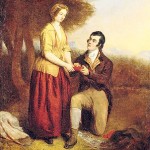Robert Burns
January 25, 2011 by staff · Comments Off on Robert Burns
 Robert Burns, Robert Burns (January 25, 1759 to July 21, 1796) (also known as Rabbie Burns, Scotland’s favorite son, the poet, farmer, Robden the Solway Firth, the Bard of Ayrshire and Scotland as simply The Bard [1] [2]) was a Scottish poet and a lyricist. It is widely considered the national poet of Scotland, and is celebrated worldwide. He is best-known poets who wrote in the Scots language, although many of his writings in English and is also a “light” Scots dialect, accessible to an audience beyond Scotland. He also wrote in Standard English, and in such civil or political commentary is often at its most brutal her.
Robert Burns, Robert Burns (January 25, 1759 to July 21, 1796) (also known as Rabbie Burns, Scotland’s favorite son, the poet, farmer, Robden the Solway Firth, the Bard of Ayrshire and Scotland as simply The Bard [1] [2]) was a Scottish poet and a lyricist. It is widely considered the national poet of Scotland, and is celebrated worldwide. He is best-known poets who wrote in the Scots language, although many of his writings in English and is also a “light” Scots dialect, accessible to an audience beyond Scotland. He also wrote in Standard English, and in such civil or political commentary is often at its most brutal her.
He is considered a pioneer of the Romantic Movement and after his death; he became a great source of inspiration for the founders of both liberalism and socialism. A cultural icon in Scotland and between the Scottish Diaspora around the world, the celebration of his life and his work became almost a national charismatic cult during the 19th and 20th centuries, and his influence has long been on Scottish literature. In 2009 he was voted by the Scottish public as the greatest Scot by a vote administered by Scottish television channel STV.
In addition to original compositions, Burns also collected folk songs from across Scotland, often revising or adapting them. His poem (and song) Auld Lang Syne is often sung at Hogmanay (the last day of the year), and Scots Wha Hae served for a long time as an unofficial national anthem of the country. Other poems and songs of Burns that remain well known throughout the world today include A Red, Red Rose, AA Man’s Man for A ‘that, of Pou; a mouse; Battle of Sherrifmuir o Tam ‘Shanter, and Ae Fond Kiss.
Who was Robert Burns.”
A Scottish poet who lived from 1759 until 1796, when he died of rheumatic heart disease. Burns’s poetry celebrated the workingman and is still popular today.
What Burns then write poems?
Auld Lang Syne for a start. He also writes.
In a mouse
Wee sleeker, cow’rin, timorous beastie,
O, what panic’s in thy breast!
You need Na start awa sae hasty,
Brattle WI bickering!
I wad be a rin Laith you out,
Pattle WI murder!
Whiskey will be drunk, read poems and traditional Scottish dishes are eaten.
Importantly, the haggis will be fed into the piper leads a procession from the kitchen followed by the titular head of a haggis aloft.
The guest then recites the Address to a Haggis before formally deciding the delicacy of sheep’s bladder.
A toast was then drunk whiskey.
More toasts followed, including the toast to the Lassies followed by Reply to the Toast to the Lassies.
The whiskey will flow and you sing in your best Scottish accent when the final Auld Lang Syne is sung.
[via wikipedia and other sources, Image from telegraph.co.uk]



